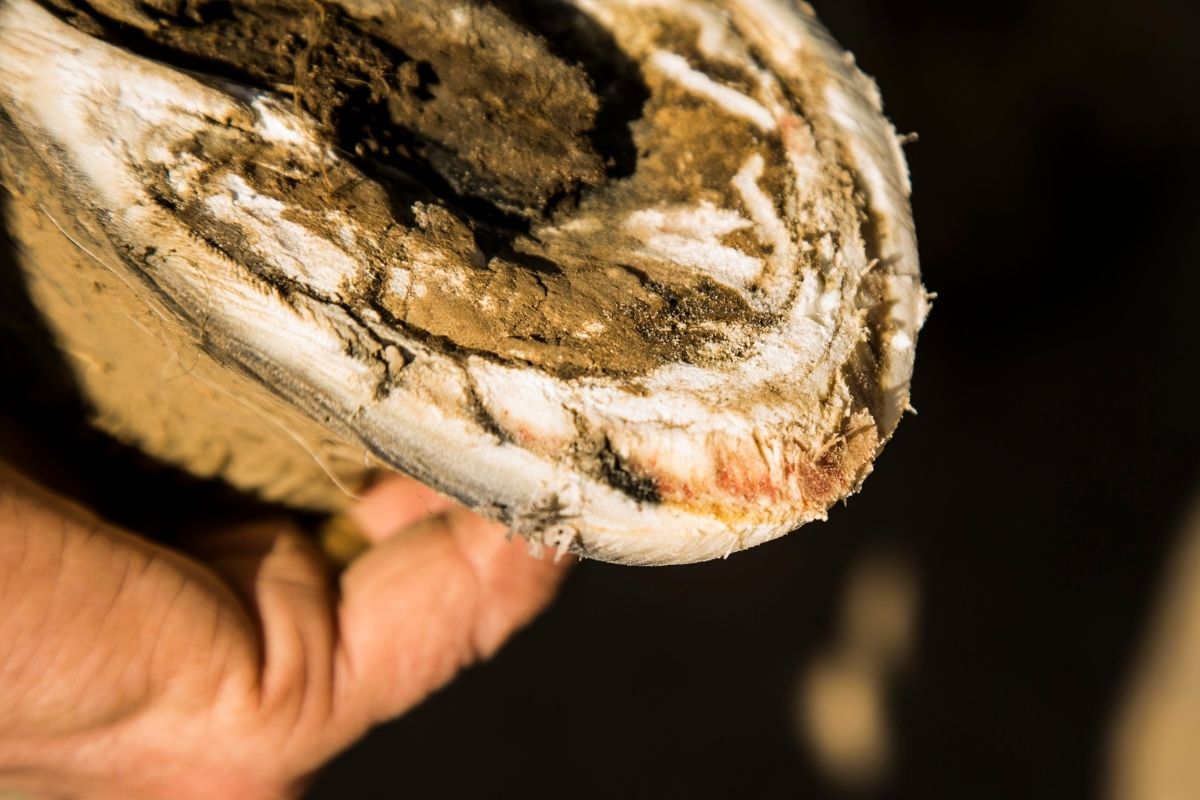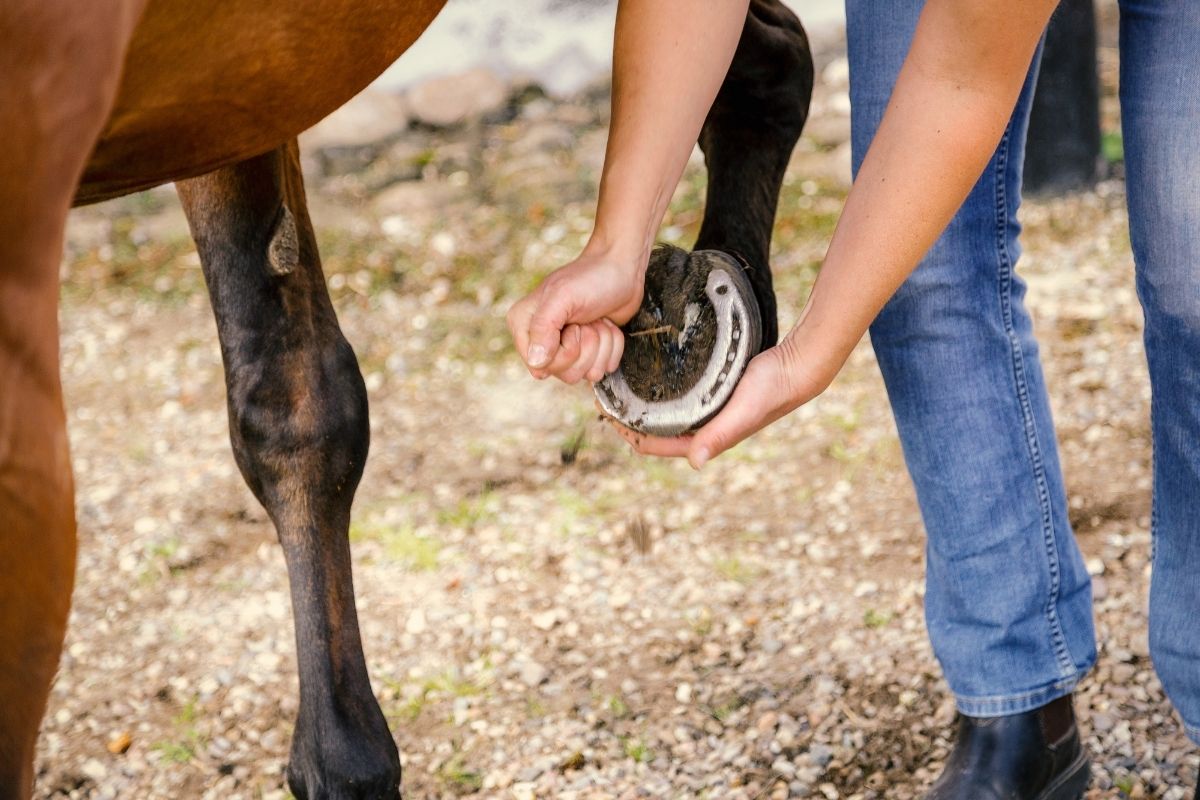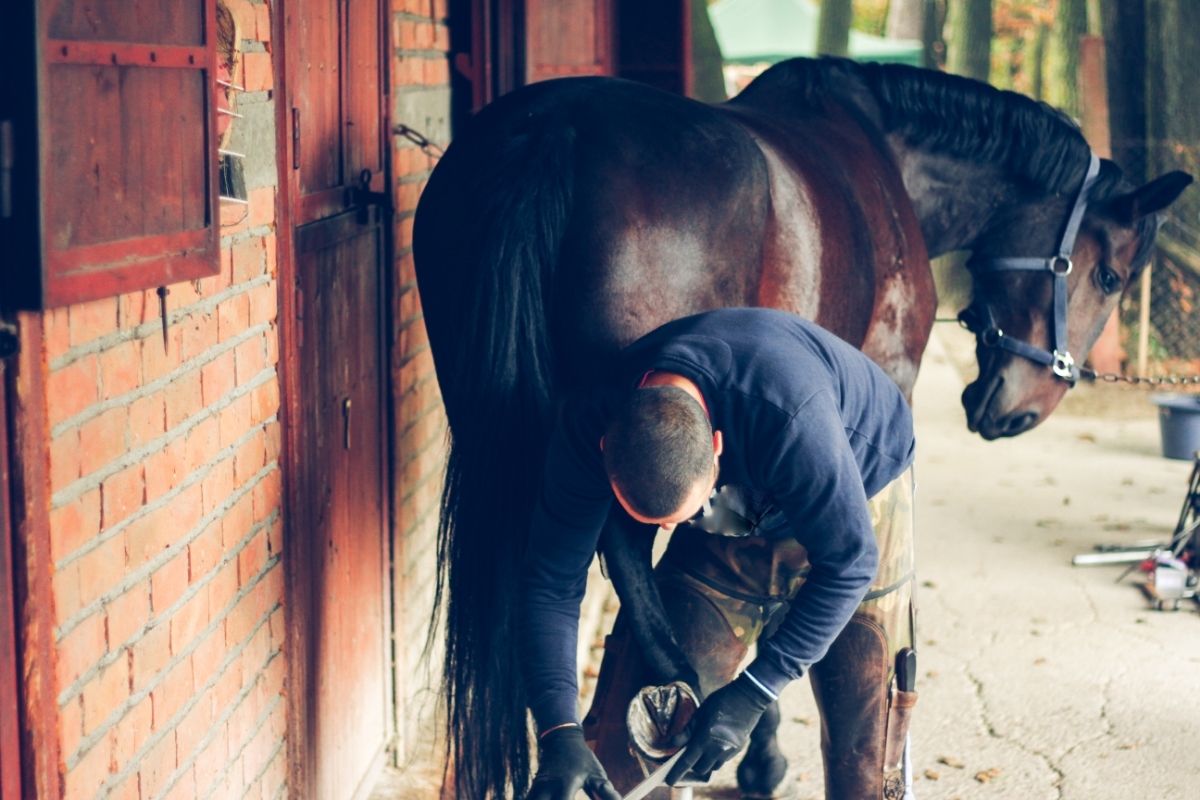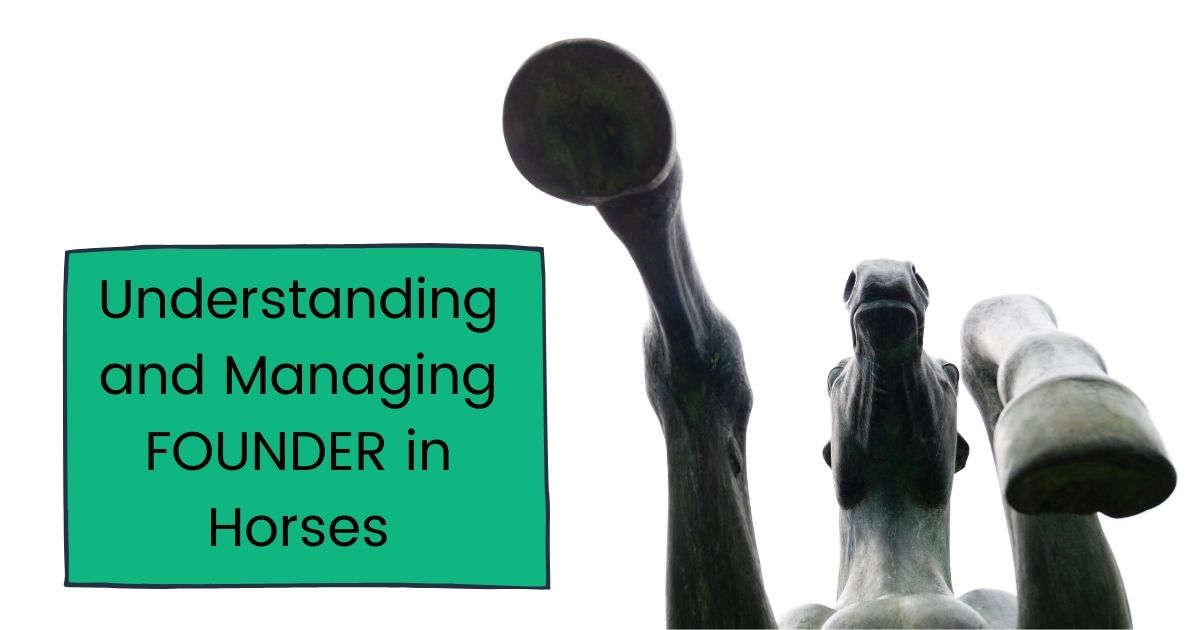What is Foundering in Horses?
Founder is also known by the technical term Laminitis and can be an extremely painful condition that affects horses’ hoofs. Founder in horses is a condition that causes inflammation in the laminae of the foot, which is defined as the delicate tissue that attaches the hoof wall to the bone in their foot (the coffin bone).
It can occur in any of the feet, although it is most common in the front.
There are two types of laminae that interlock to line the hoof and keep the coffin bone in place – sensitive and insensitive laminae. When suffering from laminitis, the horse will have a decreased blood flow to the laminae, which causes the bond between the wall and laminae to weaken and eventually causes it to separate and die permanently.
Once the laminae begin separating, it leads to hoof wall separation, extreme pain, and rotation of the cuff bone. In extreme circumstances, the coffin bone has rotated through the horse’s hoof, become infected, and can lead to euthanasia.
Signs and Symptoms of Founder in Horses
Chronic
- Bruised soles.
- Wide rings in the hoof wall.
- “Seedy Toe” (widened white line with abscesses or seromas).
- “Cresty,” thick neck.
- Dished hoofs as a result of unequal growth rates in the hoof.
Acute
- Warm feet
- Lameness and shifting weight when standing.
- Increased digital pulse within the feet (you can feel over the sesamoid bones at the fetlock level.)
- Turning in circles.
- Hesitant gait.
- Adapting a “sawhorse stance” (front feet stretched out and hind feet positioned under them to support the weight and alleviate pressure on front feet).
- When pressure is applied with hoof testers, there is a painful reaction.

Types of Founder Found in Equines
Acute Founder
As the name suggests, acute founder can be defined as the sudden breakdown of the laminae and the coffin bone. The acute symptoms are fast-acting, and you will notice the horse acts as though it has had an injury.
A sudden imbalance or injury generally causes acute founder, and you should be able to pinpoint what caused this form of founder with the assistance of your veterinarian.
Chronic Founder
If the acute laminitis continues past 72 hours, this is now considered chronic founder, and they will begin to develop chronic founder symptoms. It is generally characterized by persistent changes to the hoof wall structure and blood supply and usually has a hormonal or metabolic cause. Therefore, it can lead to long-term symptoms and/or medication.
Support-limb Founder
When trying to alleviate the weight and pain by bearing weight on another foot, the horse can develop a support-limb founder. This will begin with acute symptoms and, if left untreated, will develop into chronic founder symptoms.
What Causes Founder in Horses?
Laminitis can be a strange condition because the feet are affected, but the underlying issue is often an imbalance or disturbance somewhere else in the horse’s body. There are many different causes, with the following being the most commonly known:
- Grass founder, which is especially common in spring. This is known as the sudden access to excessive lush forage, giving the horse’s system no time to adapt to the change in diet.
- High fever and/or an illness that causes metabolic disturbances can cause laminitis.
- Toxins are released in the horse’s system or ingested accidentally.
- Severe colic.
- Grain overload can cause digestive issues and then can cause founder. Or any abrupt changes to the horse’s diet.
- If the mare retains the placenta after foaling, this can also cause laminitis.
- Weight-bearing on one leg due to an injury and any alteration of the normal gait.
- An excessive concussion can cause road founder to the feet.
- Exposure to black walnut shavings.
- Prolonged use of corticosteroids may contribute to developing founder in some horses, although this is controversial in the veterinary field.
- Various foot diseases.
How is Founder in Horses Diagnosed?
Your veterinarian can diagnose founder through the combination of a physical exam, observation or description of your horse’s symptoms, thorough discussion of their diet and lifestyle and any changes to it, and possibly bloodwork.
The general physical exam will include taking all your horse’s vital signs, including blood pressure, weight, height, temperature, respiration and heart rates, body condition score, and taking notes on their behavior.
A specific lameness examination should also be conducted to observe your horse’s standing and walking/trotting appearance, palpating the legs and feet for signs of pain, inflammation, and heat. They may also perform a static flexion to observe the range of motion.
The veterinarian will also perform hoof testing, which puts pressure on certain areas of the foot with a special tool to pinpoint the location causing pain within the hoof and the severity.
The veterinarian may also choose to perform diagnostic tests such as bloodwork and radiographs. The radiographs would be to check the alignment of the coffin bone in each of the feet. Bloodwork that may be run includes Adrenocorticotropic Hormone (ACTH), serum glucose and insulin levels, chemistry panel, complete blood count, fungal and bacterial culture, and the packed cell volume.

Treating Founder in Horses
Getting the diagnosis from the vet is the first step to identifying the primary issue that caused the founder in your horse, and the sooner the issue is diagnosed, and treatment begins, the better the chance for recovery.
Your veterinarian may consider the following steps in treating your horse for founder:
- Diagnose the primary issue and begin treating that (e.g., begin treatment for Cushing’s Disease if bloodwork presents this as such).
- Dietary monitoring and restrictions if diagnosed as a dietary issue. This may include stopping feeding all grain-based food and/or lush grass.
- Administering fluids in the case of illness-causing dehydration.
- In the case of overeating, your veterinarian may treat with a mineral oil via a nasogastric tube to purge the digestive tract.
- Antibiotics to fight an infection if present.
- Administering anti-endotoxins to reduce bacterial toxicity.
- Administering vasodilators and anticoagulants to improve blood flow to the feet by reducing blood pressure.
- Get rid of any black walnut in the bedding and ensuring your horse is stabled on soft sand or shavings to reduce pressure on the hoof.
- The veterinarian may work with your farrier to develop techniques to help alleviate the issue (e.g., corrective shoes, corrective trimming).
- If an abscess has developed, the vet will open and drain it while treating for the infection.
- The veterinarian may also recommend physiotherapy treatments.
How to Prevent Founder in Equines
Once a horse has contracted laminitis, they are susceptible to contracting it again, and preventative care measures should be in place from their diagnosis. If you have a horse that is more prone to contracting equine founder (e.g., overweight, geriatric), you may want to follow these preventative measures to ensure they are at less risk of contracting founder.
- Regular hoof trimming and/or therapeutic shoeing (if recommended by a veterinarian).
- A restricted diet that avoids excess grain and carbohydrates. Adequate nutrition should be acquired from digestible fibers, oil, and high-quality forage.
- Maintaining a healthy weight through diet and exercise.
- Nutritional supplements such as biotin for promoting hoof health.
- Avoid the dangers of grass founder by limiting the grazing in lush pastures. During the late morning and late afternoon, the plant sugars are exceptionally high, and grazing during these times should be avoided and during spring.
- To reduce the horse’s exposure to illness or disease, ensure that you keep up to date with vaccinations and parasite control.
Laminitis vs. Equine Founder
While we tend to use the terms “founder” and “laminitis” interchangeably, they actually have different meanings. When referring to the sudden acute symptoms, the correct term to use is acute laminitis. Founder generally should refer to the chronic condition of rotation of the coffin bone.
In the equine community, it is considered quite acceptable to use either term when describing this condition. However, your veterinarian may use the correct terms when diagnosing your horse.
Which Horses are More Prone to Contracting Equine Founder?
As with most medical conditions, horses with weakened immune systems will be more susceptible to contracting equine founder. In addition, other factors will make a horse more prone to contracting equine founder including:
- Overweight horses.
- Miniature horses and donkeys, ponies, and morgans.
- Large, heavy breeds.
- Horses with large, carbohydrate-heavy meals.
- Binge-eating grain (call your veterinarian immediately so that corrective action can be taken before symptoms develop).
- Horses over the age of 10.
- Horses with Cushing’s Disease.
- Horses that have previously had episodes of laminitis.

Prognosis, Recovery, and Outcome of Founder in Horses
The prognosis for horses that develop laminitis or chronic founder is guarded. It depends on the severity, the horse’s health condition, and how soon the corrective treatment begins.
Some horses can withstand the treatment and begin to heal on their own. In other cases, the veterinarian may recommend euthanasia due to constant pain and being unresponsive to treatment.
Once the initial causes of founder are assessed and treated appropriately, your veterinarian can monitor the condition of your horse based on its response to the treatment and radiographs. The radiographs will evaluate the degree of the rotation of the coffin bone and be able to detect any abscesses that form within the hoof.
As previously mentioned, once a horse has had laminitis, it is expected to recur, or that chronic founder may cause the laminae to be weakened due to the rotated coffin bone permanently. The horse’s body may also struggle with maintaining regular blood flow to the feet.
You should discuss preventative measures with your veterinarian once your horse has been diagnosed with founder. They may recommend various alternations such as diet changes, weight loss, therapeutic shoeing, ongoing radiographs, regular hoof trimming, and stabling material changes.
Conclusion
The most effective way to deal with laminitis is to put preventative measures in place to remove the causes before they can cause damage to your horse. Ensure you are monitoring the grain and lush pasture consumption of your horse carefully and that they cannot get into a position that allows them to binge eat without supervision.
If you have a horse with a weakened immune system, which is senior or simply overweight, remember that they are at greater risk to develop founder and be extra vigilant in their health care.
And as always, provide excellent routine health care and hoof care. Laminitis is considered an emergency condition, and if you suspect your horse is suffering from this condition, you should notify your veterinarian straight away!
